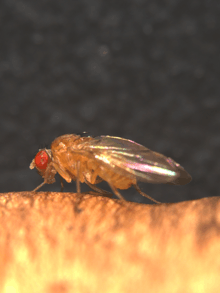Drosophila testacea species group
The Drosophila testacea species group belongs to the Immigrans-tripunctata radiation of the subgenus Drosophila, and contains 4 species: Drosophila putrida, Drosophila neotestacea, Drosophila testacea, and Drosophila orientacea. [1] Testacea species are specialist mushroom-feeding flies, and can metabolize toxic compounds in Amanita mushrooms.[2] The Testacea species group is studied for its specialist ecology, population genetics, and bacterial endosymbionts. The North American species Drosophila neotestacea is perhaps the best-studied of the group for its interactions with parasitic wasps and nematodes, bacterial endosymbionts, and trypanosomatid parasites.[3][4][5] Of note, selfish X chromosomes (a form of meiotic drive) have been discovered in three of the four Testacea group species.[6][7]
| Drosophila testacea species group | |
|---|---|
 | |
| Drosophila neotestacea | |
| Scientific classification | |
| Kingdom: | |
| Phylum: | |
| Class: | |
| Order: | |
| Family: | |
| Subfamily: | |
| Genus: | |
| Subgenus: | |
| Species group: | Testacea |
| species | |
Testacea species are commonly found in association with members of the Drosophila Quinaria species group due to their shared mushroom-feeding life history.[8]
Systematics
The Testacea species group is a phylogenetically concise lineage consisting of 4 species. The closest outgroup of Testacea species is the Drosophila bizonata species group.[9][10]
| ||||||||||||||||||||||||||||||||||||||||||||||||||||
| ||||||||||||||||||||||||||||||||||||||||||||||||||||
Gallery
 A D. neotestacea female
A D. neotestacea female A D. neotestacea female on the gills of a mushroom
A D. neotestacea female on the gills of a mushroom A D. neotestacea female on the gills of a mushroom
A D. neotestacea female on the gills of a mushroom A D. testacea male
A D. testacea male A D. testacea male on the gills of a mushroom
A D. testacea male on the gills of a mushroom A D. testacea male on the gills of a mushroom
A D. testacea male on the gills of a mushroom
Further reading
- Drosophila neotestacea
- Drosophila quinaria species group
- Spiroplasma poulsonii
- Howardula aoronymphium
References
- Grimaldi, James, and Jaenike. 1992. Systematics and Modes of Reproductive Isolation in the Holarctic Drosophila testacea Species Group (Diptera: Drosophilidae). https://academic.oup.com/aesa/article/85/6/671/2759036
- Jaenike, 1978. https://www.jstor.org/stable/1938245
- Jaenike et al. 2010. http://science.sciencemag.org/content/329/5988/212
- Haselkorn and Jaenike, 2016. https://onlinelibrary.wiley.com/doi/full/10.1111/mec.13261
- Hamilton, Phineas T.; Votýpka, Jan; Dostálová, Anna; Yurchenko, Vyacheslav; Bird, Nathan H.; Lukeš, Julius; Lemaitre, Bruno; Perlman, Steve J. (2015). "Infection Dynamics and Immune Response in a Newly Described Drosophila-Trypanosomatid Association". mBio. 6 (5): e01356-15. doi:10.1128/mBio.01356-15. PMC 4600116. PMID 26374124.
- Pieper and Dyer. 2016. https://onlinelibrary.wiley.com/doi/full/10.1111/jeb.12948
- Keais et al. 2017. https://onlinelibrary.wiley.com/doi/full/10.1111/jeb.13089
- Scott Chialvo, C. H.; White, B. E.; Reed, L. K.; Dyer, K. A. (January 2019). "A phylogenetic examination of host use evolution in the quinaria and testacea groups of Drosophila". Molecular Phylogenetics and Evolution. 130: 233–243. doi:10.1016/j.ympev.2018.10.027. PMC 6327841. PMID 30366088.
- Perlman, Steve J.; Jaenike, John (2003). "Infection Success in Novel Hosts: An Experimental and Phylogenetic Study of Drosophila-Parasitic Nematodes". Evolution. 57 (3): 544–57. doi:10.1111/j.0014-3820.2003.tb01546.x. PMID 12703944.
- Scott Chialvo, C. H.; White, B. E.; Reed, L. K.; Dyer, K. A. (January 2019). "A phylogenetic examination of host use evolution in the quinaria and testacea groups of Drosophila". Molecular Phylogenetics and Evolution. 130: 233–243. doi:10.1016/j.ympev.2018.10.027. PMC 6327841. PMID 30366088.